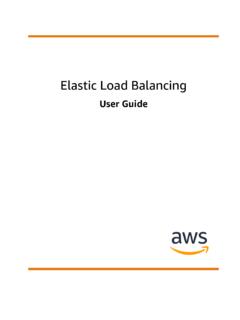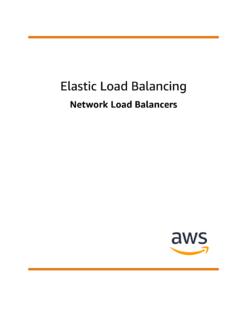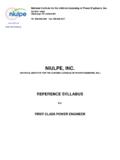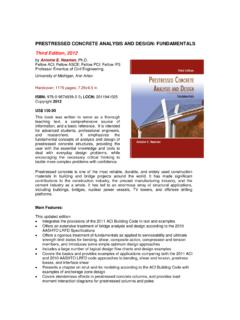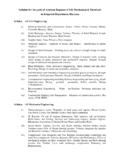Transcription of Analysis and Design of RCC and Post-tensioned Flat Slabs ...
1 Abstract The post -tensioning method is now a days increasing widely, due to its application. By using post -tensioning method one can Design the most economic and the safe Design . While using this method more precautions has to be made for shear and deflection criteria for the Slabs . The Design of Post-tensioned flat slab can be done by using load balancing and equivalent frame method. For the application of Design procedure an office building is considered as a case study. The plan of the office building (G+4) is considered. This building is designed by considering four cases with different floor systems.
2 The quantities of reinforcing steel, prestressing steel, concrete required for the slab , beam and column is calculated for the same and are presented in tabular form. Along with this total cost of the building per square meter is found and comparison of all the four cases with respect to cost is done. Index Terms Equivalent frame method, flat slab , load I. INTRODUCTION As the floor system plays an important role in the overall cost of a building, a Post-tensioned floor system is invented which reduces the time for the construction and finally the cost of the structure. In some countries, including the , Australia, South Africa, Thailand and India, a great number of large buildings have been successfully constructed using Post-tensioned floors.
3 The reason for this lies in its decisive technical and economical advantages. According to et al [1] and Y. H. Luo, A. Durrani [2] the most important advantages offered by post -tensioning systems are as follows - By comparison with reinforced concrete, a considerable saving in concrete and steel since, due to the working of the entire concrete cross-section more slender designs are possible. Smaller deflections compared to with steel and reinforced concrete structures. Good crack behavior and therefore permanent protection of the steel against corrosion. Almost unchanged serviceability even after considerable overload, since temporary cracks close again after the overload has disappeared.
4 High fatigue strength, since the amplitude of the stress changes in the prestressing steel under alternating loads are quite small. Manuscript received October 15, 2012; revised December 25, 2012. B. V. Bahoria is with Rajiv Gandhi College of Engineering and Research, Nagpur, India (e-mail: D. K. Parbat is with Government Polytechnic, Sakoli, Dist Bhandara, India. (e-mail: If a significant part of the load is resisted by post -tensioning the non-prestressed reinforcement can be simplified and standardized to a large degree. Furthermore, material handling is reduced since the total tonnage of steel (non-prestressed + prestressed) and concrete is less than for a Reinforced Concrete floor.))
5 Assembling of precast elements by post -tensioning avoids complicated reinforcing bar connections with insitu closure pours, or welded steel connectors, and thus can significantly reduce erection time. Usually the permanent floor load is largely balanced by draped post -tensioning tendons so that only the weight of the wet concrete of the floor above induces flexural stresses. These are often of the same order as the Design live load stresses. post -tensioning usually balances most of the permanent loads thus significantly reducing deflections and tensile stresses. The P/A stress provided by post -tensioning may prevent tensile stresses causing the floor to crack.
6 For the above reasons Post-tensioned construction has also come to be used in many situations in buildings. In addition to the above mentioned general features of Post-tensioned construction systems, the following advantages of Post-tensioned Slabs over reinforced concrete Slabs are listed as follows: More economical structures resulting from the use of prestressing steels with a very high tensile strength instead of normal reinforcing steels. Larger spans and greater slenderness, which results in reduced dead load , which also has a beneficial effect upon the columns and foundations and reduces the overall height of buildings or enables additional floors to be incorporated in buildings of a given height.
7 Traditional Design PT slab Design Fig. 1. Height comparison of & PT slab Design II. SCOPE OF THE PRESENT STUDY The post -tensioning method is now a days increasing widely, due to its application. By using the post -tensioning method one can Design the most economic and the safe Design . But while using this method more precautions has to 10 IACSIT International Journal of Engineering and Technology, Vol. 5, No. 1, February 2013 Analysis and Design of RCC andPost- tensioned flat SlabsConsidering Seismic Effect BoskeyVishal Bahoriaand method, Post-tensioned ,RCC, seismicanalysis, strud, : be made for the shear and the deflection criteria for the Slabs .
8 The Design of the post -tension flat slab can be done by using load balancing and equivalent frame method. Among of both the equivalent frame method is widely used. In the load balancing method the 65 to 80% of the dead load is carried by the tendon itself. So that there is an upward deflection due to tendon profile resulting the reduction in overall deflection. In the present study the Design of the Post-tensioned flat slab is done by using both methods, load balancing method and equivalent frame method. As the shear and deflection check is the most important for the Post-tensioned Slabs the detail Design for the shear and deflections (short term deflection and long term deflections due to creep and shrinkage) is carried out.
9 The parametric study of the Post-tensioned flat slab by varying the span by interval is done and results of the different parameters such as thickness of slab , grade of concrete, loss due to stress, normal reinforcement, reinforcement for the shear, number of tendons, stressing force per tendon and deflection etc. are presented in the graphical form. Continuing to this a Design of Post-tensioned beam is also done. For the study of Post-tensioned slab and beams a case study of a multistory office building (G+4) is taken and it is designed by four cases, the Post-tensioned flat slab , Post-tensioned beams and the slab , only flat slab and the slab and beams.
10 After the Design of these four cases the comparative study with respect to the economy is carried out. III. Design METHODOLOGY The Design of Post-tensioned slab is done by two methods, load balancing method and the equivalent frame method. The load balancing method introduced by T. Y. Lin is most suitable for the indeterminate structures rather than the determinate structures. In this method the 65 to 80% of dead load is balanced by the tendons so that the flexural member will not be subjected to bending stress under a given load conditions. On the other hand the equivalent frame method is widely use for the Design of Post-tensioned Slabs .


